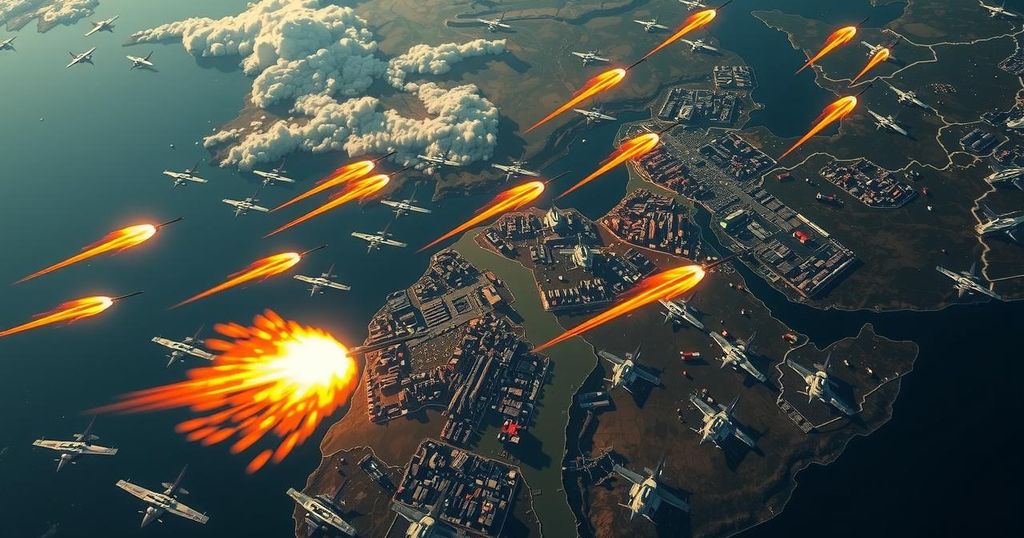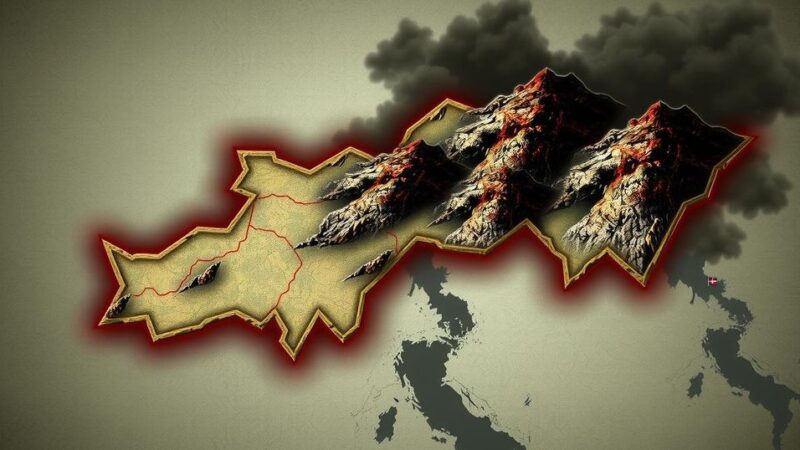Israel targeted a Hezbollah site in Syria, and the U.S. launched bombings against the Houthis in Yemen, amidst escalating regional tensions involving Iran. The conflict has claimed thousands of lives, with implications for civil safety and humanitarian issues in affected areas. As major powers reinforce their military positions, the potential for a wider regional war remains a grave concern.
On Thursday, Israel conducted a significant military strike in Syria, targeting a Hezbollah installation, as reported by a monitoring group. Meanwhile, the United States intensified its military operations in Yemen against Houthi rebel forces, deploying heavy bombers nearly one month following the escalation of conflict in Lebanon. This interconnected web of hostilities also includes the roles of Iran-aligned factions such as Hezbollah, Hamas, and the Houthis, all of which are part of an axis of resistance against perceived Israeli aggression. Iranian military leadership has issued warnings to Israel amidst tensions following a missile strike by Iran on Israeli territory on October 1, fearing a broader regional conflict. Reports from Syrian state media indicate that the recent Israeli action in Latakia, a critical stronghold for the Assad regime, resulted in at least two civilian injuries while targeting a Hezbollah weapons depot. Although the Israeli military refrained from commenting on this strike, it is part of a broader pattern, with Israel having conducted numerous airstrikes across Syria in efforts to disrupt Hezbollah’s supply lines from Iran to Lebanon. Simultaneously, U.S. military operations in Houthi-controlled Yemen involved multiple bombings on weapons facilities. The Houthis have publicly condemned these actions, vowing retaliation and reaffirming their commitment to support Palestinian causes amid ongoing hostilities in Gaza and Lebanon. Analysts suggest that the United States’ use of B-2 bombers marks a significant shift in policy, reflecting increased resolve against Houthi provocations. The ongoing conflict has resulted in tremendous human loss. Following Hamas’s initial surprise attack on October 7, Israeli fatalities reportedly numbered 1,206, mostly civilians, as Israel’s response in Gaza has led to an estimated 42,438 fatalities among Gazans, predominantly non-combatants. Concurrently, Hezbollah’s militant actions against Israel have further escalated tensions, with conflicts on the Lebanese border prompting large-scale evacuations on both sides. In Lebanon, Israeli airstrikes have resulted in numerous civilian casualties, with recent reports indicating at least sixteen deaths, including local leadership. Destruction in cities like Qana has been extensive, with rescuers highlighting the total annihilation of entire neighborhoods. The humanitarian situation continues to deteriorate, with the UN reporting catastrophic levels of poverty affecting nearly the entire Gaza population, compounded by severe restrictions on aid delivery. The Israeli government faces criticism domestically and internationally regarding its military strategies, especially in terms of civilian protection. Reports have emerged of strikes inadvertently targeting healthcare facilities, raising alarms among humanitarian organizations. Amidst these dire conditions, the UN International Labour Organization has warned that the ramifications of the conflict will reverberate for generations, indicating an alarming unemployment rate of approximately 80% in Gaza.
The conflict involving Israel, Hezbollah, Hamas, and the Houthis is deeply intertwined within regional geopolitics, particularly influenced by Iranian support. This axis of resistance responds to perceived aggressions primarily from Israel, resulting in a cycle of military retaliation and humanitarian crises. Given the ongoing hostilities in Lebanon, Syria, and Gaza, the international community is observing with concern as these conflicts threaten to escalate into a broader regional war. The involvement of major military powers, such as the United States and Israel, adds a complex layer, as both align with strategic interests while balancing humanitarian considerations. The ongoing escalations have led to alarming casualty figures and significant displacement, emphasizing the urgent need for diplomatic intervention and resolutions.
The recent military actions by Israel and the United States against Hezbollah and Houthi positions underscore an intensifying conflict with broad implications for regional stability. Both nations continue to face challenges regarding civilian safety amidst ongoing hostilities. The death toll in Gaza and Lebanon highlights the severe humanitarian crisis that is unfolding, necessitating urgent international attention and intervention. As military operations escalate on multiple fronts, the risk of a comprehensive regional conflict grows, further complicating efforts towards a sustainable resolution.
Original Source: www.newarab.com






